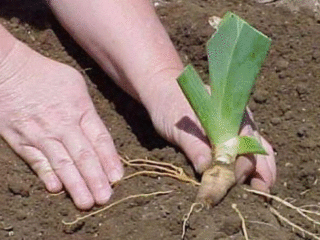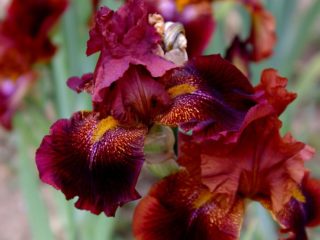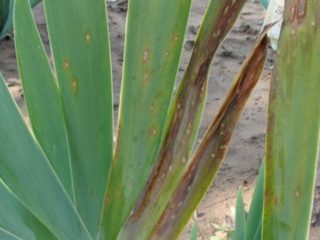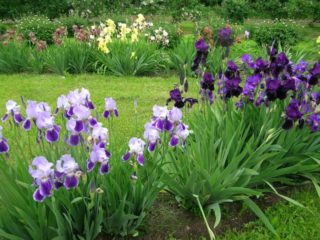Content
The dwarf iris is often used for decorative purposes. This is an unpretentious plant that does not need specific care. Iris is practically insensitive to diseases, rarely attracts pests. Thanks to these features, this flower will be the perfect solution for both beginners and experienced gardeners.
Description of dwarf irises
It is a perennial undersized plant. Most species of dwarf iris (Iris pumila) do not exceed 20 cm in height.Some varieties reach 40 cm.
Despite the short stature, the size of the buds is practically the same as other, taller flowers. The color depends on the variety. Irises can be purple, yellow, lilac, or any other shade.
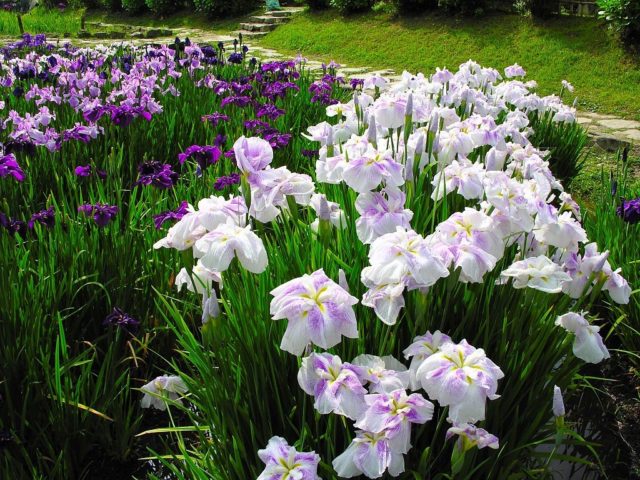
Iris bloom lasts up to 1 month
A large number of peduncles grow on each bush. 2-3 flowers appear on them.
Unlike tall iris species, dwarf ones begin to bloom in the second year after planting. These bushes also have abundant dark green foliage, which retains an attractive appearance until late autumn.
Low-growing irises varieties
There are a large number of varieties that differ in external characteristics. Therefore, you should consider the main varieties of dwarf iris with photos and names.
Cats Eye
The Iris Pumila Cat's Eye variety is one of the most common among low-growing irises. The height of the plant is 18-20 cm. During the flowering period, peduncles appear on it, due to which the bush increases to 30 cm.
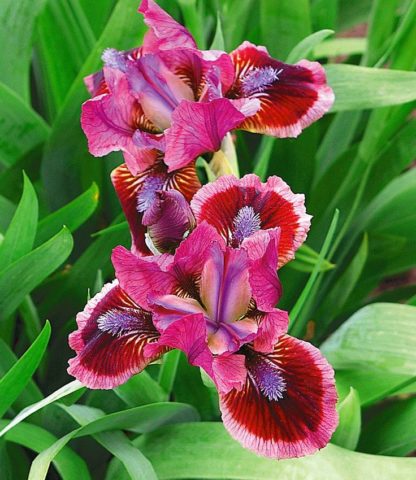
Iris Cats Ay blooms from the end of April
The flowers of the plant have a double color. The upper part is plum pink, and when blooming takes on a slightly golden hue. The lower lobe is velvety. The petals have cherry spots in the center and whitish streaks at the base.
Larricin
Iris pumila Larrikin has a unique lilac color. The plant has a large number of basal linear leaves with an indistinct bluish tinge.
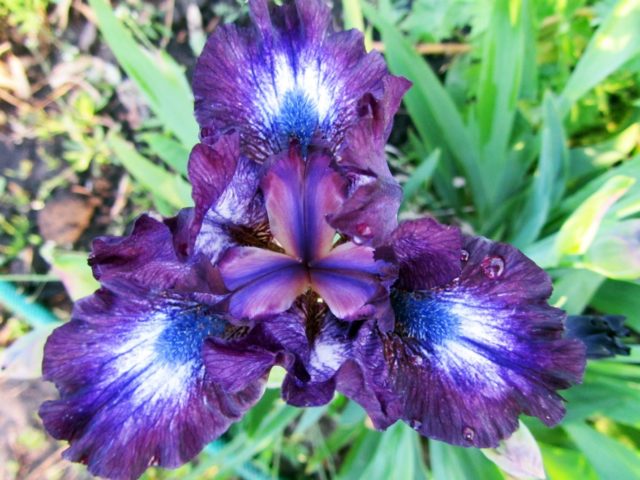
Flowers on dwarf iris Larricin reach a diameter of 15 cm
The budding period takes place at the beginning of May. Subsequently, a large number of dark flowers appear on the plant. They are lilac in color with light spots in the center of the petals. The flowering period is from late May to mid June.
Blue Denim
Dwarf hybrid cultivar Iris pumila Blue Denim is characterized by resistance to cold and other unfavorable factors. The height of the bushes is 20-25 cm.

Iris Blue Denim is best planted in partial shade to protect the petals from burning out.
During the flowering period, which lasts from late March to mid-April, light blue flowers appear on the dwarf iris. The petals have slightly corrugated edges.
This variety is best suited for planting in rockeries, rock gardens. After flowering, they decorate the area with their dense foliage.
Galleon gold
Galleon Gold is a standard dwarf iris. The height of the bushes is 20-30 cm. The plant is used for landscaping, in flower arrangements and for single planting. The leaves of such an iris are gray, long, dense.
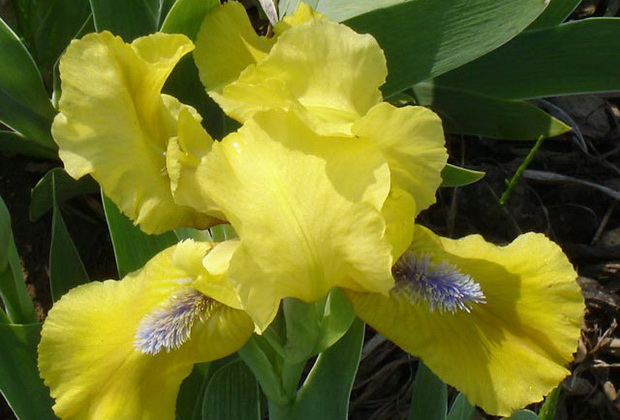
Due to its resistance to frost, Iris Galleon Gold is grown in all climatic zones.
Flowers up to 10 cm in diameter. Color - bright yellow with a purple beard. Flowering lasts up to three weeks. It usually starts in mid-May and ends in early June.
Cherry Garden
Iris pumila Cherry Garden is a low-growing plant with several central and side stems. It has long, feathery, dark green leaves. The flowers are dark purple with a lilac tint.
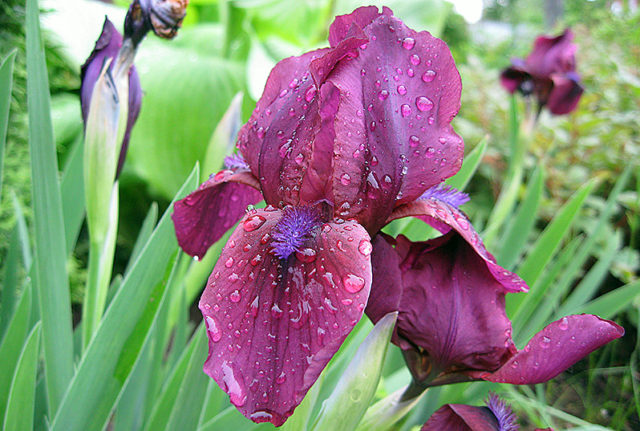
Iris Cherry Garden blooms at the end of May
The flowering period lasts 3-4 weeks. After that, the plant retains its decorative properties due to the abundant green foliage.
This variety is recommended to be planted in areas well-lit by the sun. With enough light, the plant can bloom again in the fall.
Demon
Iris pumila Daemon has a unique charcoal black color. Plant height is standard for dwarf irises and does not exceed 30 cm. The plant blooms in late April throughout May. In the future, the bush performs a decorative function, landscaping the area with dense foliage.
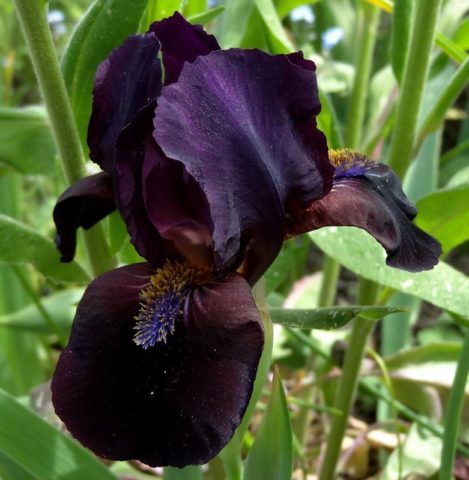
The duration of flowering directly depends on the content of minerals in the soil.
The Demon variety is recommended to be planted in well-lit areas. Planting in the shade negatively affects the development of the dwarf iris and may result in it not blooming.
Brassi
Variety Iris pumila Brassie - standard dwarf iris, height 20-25 cm. The plant is used for group planting in open areas, in rockeries and alpine slides.
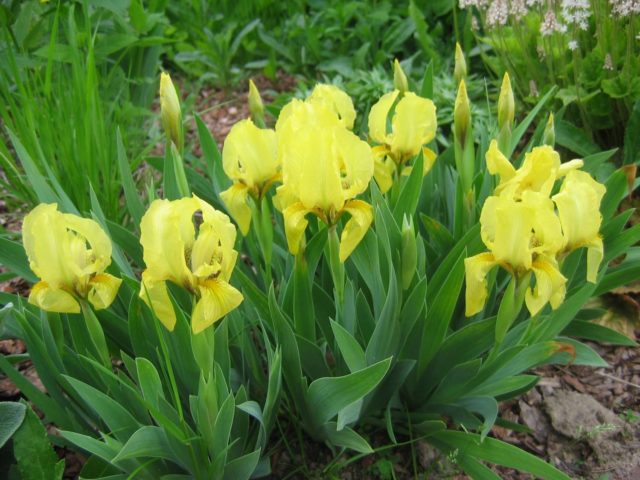
Iris Brassi is planted in shaded areas to prevent the petals from discoloring in the sun
The budding period lasts from early to late May. In the future, bright yellow flowers with a diameter of 8-10 cm appear on the dwarf iris. Up to 30 buds are formed on each bush.
Dwarf irises in landscape design
They are usually planted next to other ornamental plants that bloom in spring or summer. In the photo of dwarf irises, it is noticeable that they combine well with other low crops.
These include:
- daffodils;
- tulips;
- pushkinia;
- alissums;
- cuts;
- phlox.
Often, dwarf iris varieties are used to frame borders, artificial reservoirs, and other elements of garden decor. Such flowers can be planted in beddings.
Due to their compact size, dwarf irises are perfect for planting in containers, flowerpots and pots. They are often used to make hanging decorations on verandas and terraces.
Breeding features
The most convenient way is to divide the roots. The procedure is carried out in the summer, after the end of flowering.
Stages of the procedure:
- Choose a healthy bush from 3 years old.
- Dig up from the soil.
- Extract with a root ball.
- Remove solid pieces of soil.
- Separate the root section with several buds.
- Place the mother shrub back into the ground.
- Place the rag in a manganese solution for 2 hours and then dry.

After the delenki procedure, it must be dried in the open air.
Planting material is planted in July or August. Then the young plants will have time to take root, endure the winter well and bloom the next year.
Planting low-growing irises
It is necessary to take a responsible approach to the selection of a site for a dwarf plant. For low irises from the Red Book, well-lit places are best suited. Some varieties can be planted in partial shade. However, iris cannot be planted in areas where the bushes have no access to sunlight.
The acidity of the soil for irises is neutral. The optimal value is 6-7 pH. Plants do not tolerate stagnant liquid in the ground. Therefore, it must contain a drainage layer.
Dwarf irises are planted from April to early autumn. The plant quickly adapts to a new place, takes root and grows actively.
Landing Algorithm:
- Choose a suitable place.
- Clear the area from weeds, dig it up.
- Apply nitrogen-phosphorus fertilizer to the soil, 30 g per 1 sq. m.
- Dig shallow holes.
- Place delenki in them so that the root collar is located on the surface.
- Sprinkle with plenty of water.
- Cover the soil with fine gravel or coarse sand.
Abundant watering is recommended for the first 5 days. In the future, it is gradually reduced.
Care features
Dwarf irises are undemanding plants. They grow well without regular feeding.
Fertilizers are recommended to be applied in spring, before budding begins. For these purposes, potash and phosphorus solutions are used.
In late spring and throughout the summer, the plant needs abundant watering. Under each bush, it is necessary to add 5-6 liters of liquid. This is best done in the evening to reduce solar evaporation.
Caring for dwarf irises also involves the following activities:
- loosening the soil - 1-2 times a month, depending on the speed of compaction;
- soil mulching - 2-3 times during the growing season;
- regular weed removal near bushes;
- pruning wilted peduncles, dried shoots and leaves.
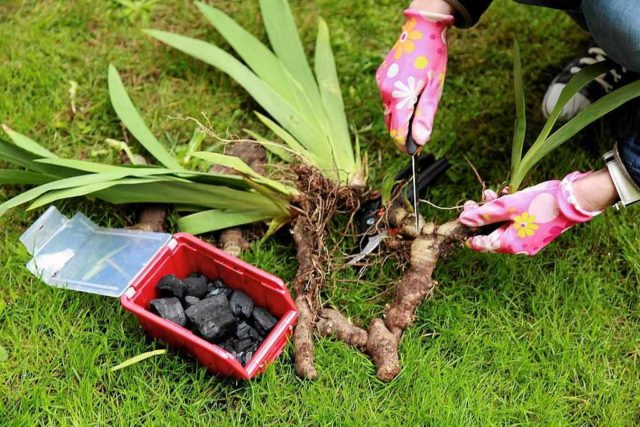
Every 5-6 years, irises should be divided and transplanted to a new location.
This procedure is usually carried out in the autumn. However, it can also be carried out in the summer. At the same time, surface shoots are removed from the plant at a height of 6-7 cm.
Diseases and pests
Irises are resistant to infections. However, they can be affected by fungi or viruses due to improper care.
The most common diseases are:
- bacteriosis of rhizomes;
- rhizoctonia;
- fusarium rot;
- botrytis;
- leaf spot;
- rust.

Most diseases provoke the gradual wilting of irises.
In the photo of a low iris, it is noticeable that due to infection, its flowers began to deform and dry. This usually happens due to improper care of the bushes and a gross violation of the cultivation technology.
For the treatment of the described diseases, complex fungicidal preparations are used. They must be used in strict accordance with the instructions. If the leaves and flowers are damaged, they must be cut off in order to prevent the spread of infection to healthy bushes.
Preventive recommendations:
- Prevent stagnation of liquid in the soil.
- Refuse fertilization with fresh manure, droppings.
- Use disease-resistant iris varieties for planting.
- Add lime to the soil to reduce acidity.
- Observe the watering regime.
- Avoid drought.
- Do not replant shrubs during flowering.
Similar recommendations help in the prevention of pest infestation. In spring and after flowering, dwarf irises need to be treated with insecticides. This will prevent damage by bears, slugs, aphids.
Conclusion
Dwarf iris is a low-growing ornamental plant with large flowers. This perennial has gained popularity among landscape designers despite its relatively short flowering period. The demand for different varieties of dwarf irises is due to the fact that they are easy to grow even for inexperienced gardeners.




